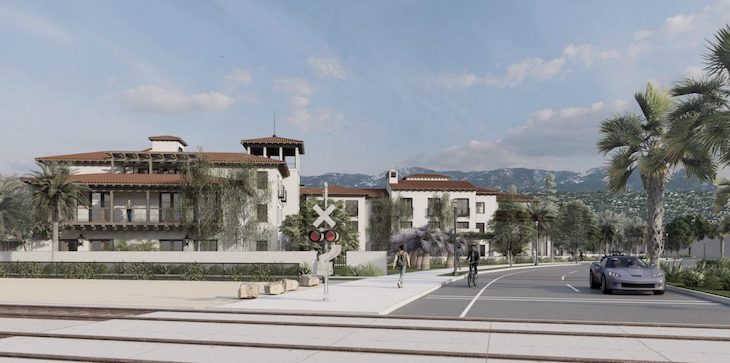After a lengthy multi-hour meeting this week, the Santa Barbara Planning Commission has given the green light to a 250-room hotel project in the Funk Zone.
The 4-2 decision to approve the hotel project, located at 101 Garden Street, was not without its challenges and differing opinions among the commissioners. Two commissioners, John Baucke and Devon Wardlow, voiced concerns about the lack of matching housing units for the new jobs that the project would create. They felt that more environmental review was necessary and called for increased housing on the site. However, Commissioners Brian Barnwell, Donald DeLuccio, Lesley Wiscomb, and Sheila Lodge ultimately voted in approval.
Sean Gilbert, the developer’s representative, expressed the site was designated for a hotel in the city’s Housing Element, not housing. He agreed to include six studios for employees to live in and pledged a $500,000 contribution to the city’s Housing Trust Fund. Of the housing units, five would be low income studios and one a moderate income two-bedroom unit.
The three-story hotel is proposed on a a 4.5 acre parcel from the corner of Garden and Yanonali Streets to the railroad tracks and towards the corner of Santa Barbara and Mason Streets. It’s comprised of six lots that the owners have proposed merging. It’s essentially the majority of the 100 block wrapping around the former Michael Kate Contemporary Furniture, Topa Topa, and Lama Dog buildings. Five existing structures totaling 15,200 square feet would be demolished.

Amenities for the hotel include a library, bar, lounge, 208-square-foot market, media salon, meeting rooms, living room, breakfast area, outdoor seating areas with spa, courtyard with pool and spa, fitness room, a 7,500-square-foot roof deck, and 267 parking spaces. While 120 of the rooms will be standard hotel rooms, the remaining 130 will be “extended stay” offering larger bathrooms, kitchens, and sleeper sofas.
The history of the property dates back to 1983 when the Wright Family obtained approval for a Specific Plan that allowed for both hotel and housing uses. Subsequent proposals for residential condominiums were withdrawn due to profitability concerns, leading to the current hotel project that received favorable comments during a 2019 concept review.
While concerns were raised about the project’s impact on housing and the Funk Zone’s ambiance, developers highlighted the Wright Family’s past contributions to the community. Additionally, the planning staff confirmed that the project was exempt from needing an environmental impact report.
Local nonprofit Keep the Funk S.B., has been a vocal opponent of this project and other large-scale developments planned for the Funk Zone neighborhood.
“The hotel would uproot dozens of local businesses and local artists that have been on the site for decades,” the group wrote on its Instagram page prior to the meeting. “The Funk Zone is not in any way, shape, or form the neighborhood that it used to be in 1983. And it certainly doesn’t need another hotel.”
As the commission ultimately approved the Garden Street Hotel Project, the decision remains subject to appeal within the next 10 days. The clash of opinions and concerns expressed throughout the hearing reflects the complex dynamics surrounding development projects in Santa Barbara, underscoring the ongoing dialogue between stakeholders and decision-makers.








Isn’t there a water shortage? Idiots
Good lord abolish the planning commission. You dont want their hotel then gov then their damn land back THAT THEY DONATED TO THE CITY EXCHANGE FOR PERMISSION TO BUILD A HOTEL!
I walk in this area frequently, and that entire block is an embarrassing eyesore. My only complaint would be that more housing would be nice. Otherwise, the planned development will greatly improve what is there now.
The City’s determination that the project is “mixed use” is incorrect. The project is “Other Residential”. Subgrade parking below “Other Residential” is not allowed in flood zones. The PC vote is irrelevant; the project will never get flood insurance, and thus won’t get built.
Interesting! Is this a ploy by the developer to get certain approvals, and then finagle exceptions to the parking rules because “oh poor us, we’ve gotten so far, but now ran into this flood insurance obstacle” ?
Possibly. SBMC 22.24.070 gives the Floodplain Administrator authority to administratively “waive the rules”. But to do so, a documented analysis must be filed. No such analysis has been filed to date. FEMA also allows exceptions, with conditions that this project can not meet.
The real puzzle is: when did the applicant figure out this was a problem? I do not think the applicant had a clue until I objected at the 8-3-2023 hearing. The staff report for that hearing said nothing about ASCE 24 constraints on subgrade parking. I contacted the former Floodplain Administrator (brought out of retirement) on Sept 5; he said he would get back to me after “management review”. He replied Oct 19, and provided critical information. The critical information? If 25% of the project is non-residential, subgrade parking is allowed. But never in a millions years did I consider the parking area itself could count towards the non-residential area. And I am sure it does not. Just waiting for smoking gun evidence from the FEMA experts. Stay tuned.
Thank you for keeping on top of this.
Update: the key player is the ASCE 24 committee currently updating the standard, and hopefully providing a coherent definition of “mixed use”. But I am doubtful the new standard will be released for public comment prior to the City Council appeal (scheduled for June 25). I do know that FEMA explicitly states that the definition the City mostly recently employed should NOT be used.